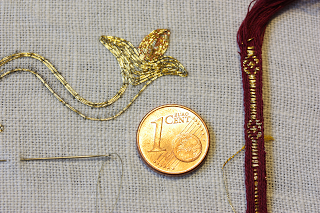A while ago - last autumn, to be precise - I was asked about a workshop or course on tablet weaving. This has been on my agenda for a while, and I have taught tablet weaving before, but not just the course I really want to teach.
Said course, as I plan it, will be suitable for beginners as well as for people who already know a bit about tablet weaving. It will be teaching solid basics, with a strong emphasis on the underlying mechanics - so after the course, you will have an understanding of what happens when and why. With that understanding, reading and making (writing and designing) your own patterns will be possible. And if you feel so inclined, you will also have the tools necessary to work 3/1 broken twill patterns.
This is, admittedly, a stiff programme. Which means it needs careful developing (what will I introduce when? For the many elements of tablet weaving that are linked together, how can I best structure them?) and also time-management (which includes deciding on whether I will teach how to setup the warp or not, and whether to prepare warps for the participants or not).
There's also the problem of logistics. There's a difference in necessary equipment between teaching a simple introduction and teaching the course I have in mind. I have space, but I will also need either a lot of table space or a lot of (simple, medieval-style) tablet-weaving frames. I also need tablets that are both suitable for the weaving that we'll do (as in large enough) and affordable, plus suitable yarn in at least two colours and enough length.
So all this has been stewing in the background for a good while now, and yesterday I finally solved the yarn-and-tablets problem. Which means two things: a lower price alternative to the parchment tablets will turn up in the shop very soon, and I can finally do a test-run for the weaving course plan that I have!
Said course, as I plan it, will be suitable for beginners as well as for people who already know a bit about tablet weaving. It will be teaching solid basics, with a strong emphasis on the underlying mechanics - so after the course, you will have an understanding of what happens when and why. With that understanding, reading and making (writing and designing) your own patterns will be possible. And if you feel so inclined, you will also have the tools necessary to work 3/1 broken twill patterns.
This is, admittedly, a stiff programme. Which means it needs careful developing (what will I introduce when? For the many elements of tablet weaving that are linked together, how can I best structure them?) and also time-management (which includes deciding on whether I will teach how to setup the warp or not, and whether to prepare warps for the participants or not).
There's also the problem of logistics. There's a difference in necessary equipment between teaching a simple introduction and teaching the course I have in mind. I have space, but I will also need either a lot of table space or a lot of (simple, medieval-style) tablet-weaving frames. I also need tablets that are both suitable for the weaving that we'll do (as in large enough) and affordable, plus suitable yarn in at least two colours and enough length.
So all this has been stewing in the background for a good while now, and yesterday I finally solved the yarn-and-tablets problem. Which means two things: a lower price alternative to the parchment tablets will turn up in the shop very soon, and I can finally do a test-run for the weaving course plan that I have!





